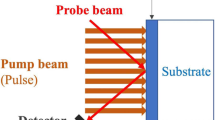Abstract
The micro-contacts in the granules of the high-temperature superconductor (HTSC) films and other polycrystalline objects after transition to the SC state would then be similar to a bulk superconducting quantum interference device (SQUID), with the point S-N-S state greatly enhancing the sensitivity to electromagnetic radiation and can be used as of the application for much higher resolution than ever before possible (Braginsky, NATO ASI Series, 329, 235 (1996); Bray, J. Supercond. Novel Magn., 21, 335–341 (2008); Cantor, Supercoduct. & Cryoelectronics, 2000). Production of SQUIDs based on thin films is a very complicated technological process, requiring very expensive equipment. Use of the composite (HTSC powder + epoxy matrix), compressed SC powder, and thick films for SQUID fabrication should be very much simpler. The range of frequencies that can by detected with such a device will depend on the circuit parameters and may be extended to the microwave or infrared regimes (Braginsky, NATO ASI Series, 329, 235 (1996); Jurga et al. Acta Phys Pol A, 114, (2007); Jurga et al., Acta Phys Pol A, 114, (2007)). The advantage of the bulk SQUID based on HTSC-YBa2Cu3O x , BiSr2Ca2Cu3O X , B(Pb)iSr2Ca2Cu3O X , and NdBaCo X (powder + epoxy matrix, compressed SC powders, and thick films) is the non-selective nature of the spectral characteristics over a wide frequency range, high sensitivity, and quick response. For suppressing the large noise resulting from the maximal instability of electromagnetic properties at the SC, insulator transition is employed a differentiation procedure of the measurements signal.







Similar content being viewed by others
References
Braginsky, A.I.: Fabrication of HTSC SQUID magnetometers, SQUIDs sensors: fundamentals, fabrication and applications. NATO ASI Series 329, 235 (1996)
Bray, J.W.: Superconducting applications: present and future. J. Supercond. Nov. Magn. 21(6), 335–341 (2008)
Wasko, S.: HTS wireless applications report Ⓒ1998 WESTTECH
Cantor, R.: SQUID and emerging application (2000)
Talisa, S.H., Janocko, M.A., Meier, D.L., et al.: HTSC-space-qualified multiplex and delay lines. IEEE Trans. Microwave Theory Tech. 44(7), 1229–1239 (1999)
Broide, E.L.: Electromagnetic separation of the HTSC powders, Springer, Journ. of Supercond. and Novel Magnetism. Springer (2000)
Kim, B.F., Bohandy, J., Moorjani, K., Adrian, J.: J. Appl. Phys. 63(6), 15 (1988)
Bobil, A.V.: Abstract of the doctors thesis entitled: Defects of the epitaxial BiSr2Ca2Cu3OX, films as sources of flicker noise (1999)
Testa, J.A., Song, Y., Chen, X.D., Golben, J., Lee, S., Patton, B.R., Gaines, J.: 1/f-noise-power measurements of copper oxide superconductor. Phys. Rev. B 38, 2922 (1988)
Komissinski, A.P., Ovsyannikov, G.A.: Current transport in Au/YBa2Cu3Ox junctions in c-axis and tilted directions of YBa2Cu3Ox thin films, Appl. Supercond, Spain 14–17, 9, 1999, IOP Publishing Ltd (2000)
Kimmel, W.D., Partner, P.E., Gerke, K.: Associates, Ltd, Effective EMI shielding in military environment Defense & Sec. Technology (2013)
Broide, E.: Detection and stimulation of impulse EM-radiation of radio-frequency by resonant circuit with HTSC-element, Mat. Res Innovat. 1999, 207-210 (1999). ©Springer-Vering
Yetis, H., Altinkok, A., Olutas, M., Kilic, A.: J. Phys. Conf. Ser. 43, 436351742–6596 (2006)
Mazzetti, P., Tura, P., Masoero, A., Stepanescu, A.: Conductance noise in polycrystalline HTSC immersed in a slowly varying magnetic field. Phys. Rev. B 65, 132512 (2000)
Kang, W.N., Kirn, D.H., Park, J.H., Hahn, T.S., Choi, S.S., Gray, K.E.: Origin of 1/f noise peaks of YBa2Cu3oX, films in a magnetic field. Physica C 233, 402 (1994)
Ponta, L., Carbone, A., Gilli, M., Mazzetti, P.: Resistive layers formation during the SC-N-transition. In: 2009 IEEE Toronto Intern. Conf. Toronto (CAN), pp 855–860 (2009)
Hylton, T.L., Beasle, M.R.: Effect of grain boundaries on magnetic field penetration in polycrystalline superconductors. Phys. Rev. B 39, 9042–9048 (1989)
Kawasaki, M., Chaudhari, P., et al.: Sub-micron YBa2Cu3Ox grain boundary junction DC-SQUIDs, SC Devices and Their Applic. Springer Proceed. Phys. 64, 150–154 (1992)
Jurga, W., Piekara-Sady, L., Gazda, M.: Proceedings of the XIII National School of Superconductivity, Ladek Zdroj. Acta Phys. Pol. A 114 (2008) (2007)
Vendik, I.B., Vendik, O.G., Samoilova, T.B.: High temperature superconductor devices for microvawe signal processing, Part III, St. Peterburg, 29.07.1997, 19906, p/o 296
Kim, B.F., Bohandy, J., Moorjani, K., Adrian, F.: Novel microwave technique for detection of superconductivity. J. Appl. Phys. 63(6), 15.03 (1988)
Jolly, W.P.: Cryoelectronics, pp 72–82. Univers. Press. Ltd. (1972)
Jurga, W., Piekara-Sady, L., Gazda, M.: Microwave absorption study on (Bi, Pb) granular superconductors. Acta Phys. Polon. 114 (2008)
Golosovsky, M., Tsindlekht, M., Davidov, D.: Microvawe propagation through SC-polymer composites. Phys. Rev. B 46(18), 199225
Broide, E.: Method of Separating HTSC Fraction, US Patent 5,919,737 (1999)
Colclough, M.S., et al.: Nature 328(4), 47–48 (1987)
The effect of the resonant mode structure on flux tunnelling in SQUIDs A.I.M. Rae and C.E. Gough. J. Low Temp. Phys. 65, 399–423 (1986)
Gershenson, E.M., Gershenson, M.E., et al.: J. GTF 59(N2), 111–120 (1989). Russia
Acknowledgments
The author would like to thank Ing. A. Fadeev (“Rosna”, Ltd, Russia, Ekaterinburg) for manufacturing of the HTSC thick films and Piter Gulko, USA Eurotec official representative. The author personally would like to thank Prof. Yosef Yeshurun, Bar-Ilan University, Israel’s Department Physics Properties of High-Temperature Superconductors and Disordered Magnetic systems; Prof. Eli Zeldov, The Weizmann Institute of Sci., Rechovot, 76100, Israel; Prof. David Kessler, for reduction of the text article; and Ing. D. Rubin and Ing. M.Broide for help in experiments(Separator, Ltd).
These investigations were supported in frame by the Russian National Program and Israel’s research programs. YBa2Cu3Ox (123-compound) was produced in the Chemical Plant (Yekaterinburg, Russia). Bi(Pb)-HTSC was synthesized in Kharkov Institute of Noncrystalline (Ukraine), Praxair (USA), and Czech Republic; Nd-SC specimens were produced by Dr. G. Shter in Technion, Israel.
Author information
Authors and Affiliations
Corresponding author
Rights and permissions
About this article
Cite this article
Broide, E. EM Radiation Sensor: Bulk SQUID Made from Polycrystalline HTSC. J Supercond Nov Magn 28, 1931–1936 (2015). https://doi.org/10.1007/s10948-015-2991-z
Received:
Accepted:
Published:
Issue Date:
DOI: https://doi.org/10.1007/s10948-015-2991-z




